Note
Go to the end to download the full example code.
EstimatorReport: Get insights from any scikit-learn estimator#
This example shows how the skore.EstimatorReport class can be used to
quickly get insights from any scikit-learn estimator.
Loading our dataset and defining our estimator#
First, we load a dataset from skrub. Our goal is to predict if a healthcare manufacturing companies paid a medical doctors or hospitals, in order to detect potential conflict of interest.
from skrub.datasets import fetch_open_payments
dataset = fetch_open_payments()
df = dataset.X
y = dataset.y
Downloading 'open_payments' from https://github.com/skrub-data/skrub-data-files/raw/refs/heads/main/open_payments.zip (attempt 1/3)
from skrub import TableReport
TableReport(df)
| Applicable_Manufacturer_or_Applicable_GPO_Making_Payment_Name | Dispute_Status_for_Publication | Name_of_Associated_Covered_Device_or_Medical_Supply1 | Name_of_Associated_Covered_Drug_or_Biological1 | Physician_Specialty | |
|---|---|---|---|---|---|
| 0 | ELI LILLY AND COMPANY | No | Allopathic & Osteopathic Physicians|Pediatrics|Pediatric Rheumatology | ||
| 1 | ELI LILLY AND COMPANY | No | Allopathic & Osteopathic Physicians|Internal Medicine|Nephrology | ||
| 2 | ELI LILLY AND COMPANY | No | Allopathic & Osteopathic Physicians|Internal Medicine|Rheumatology | ||
| 3 | ELI LILLY AND COMPANY | No | Allopathic & Osteopathic Physicians|Internal Medicine|Endocrinology, Diabetes & Metabolism | ||
| 4 | ELI LILLY AND COMPANY | No | EFFIENT | Allopathic & Osteopathic Physicians|Pediatrics|Pediatric Hematology-Oncology | |
| 73,553 | GlaxoSmithKline, LLC. | No | ZIAGEN | ||
| 73,554 | ALERE SCARBOROUGH, INC. | No | Alere PBP2a | ||
| 73,555 | NovoCure Limited | No | |||
| 73,556 | Wright Medical Technology, Inc. | No | HIPS | ||
| 73,557 | Alcon Research Ltd | No | Express |
Applicable_Manufacturer_or_Applicable_GPO_Making_Payment_Name
ObjectDType- Null values
- 0 (0.0%)
- Unique values
-
1,466 (2.0%)
This column has a high cardinality (> 40).
Most frequent values
Merck Sharp & Dohme Corporation
Novartis Pharmaceuticals Corporation
Pfizer Inc.
Boston Scientific Corporation
Covidien Sales LLC
Stryker Corporation
SANOFI-AVENTIS U.S. LLC
AstraZeneca Pharmaceuticals LP
Genentech USA, Inc.
List:AbbVie, Inc.
['Merck Sharp & Dohme Corporation', 'Novartis Pharmaceuticals Corporation', 'Pfizer Inc.', 'Boston Scientific Corporation', 'Covidien Sales LLC', 'Stryker Corporation', 'SANOFI-AVENTIS U.S. LLC', 'AstraZeneca Pharmaceuticals LP', 'Genentech USA, Inc.', 'AbbVie, Inc.']
Dispute_Status_for_Publication
ObjectDType- Null values
- 0 (0.0%)
- Unique values
- 2 (< 0.1%)
Most frequent values
No
Yes
['No', 'Yes']
Name_of_Associated_Covered_Device_or_Medical_Supply1
ObjectDType- Null values
- 43,088 (58.6%)
- Unique values
-
4,372 (5.9%)
This column has a high cardinality (> 40).
Most frequent values
Vascular
Spine
ARTHREX PRODUCT LINE DISTAL EXTREMITY ARTHROSCOPY
Surgical
ALL ARTHREX PRODUCT LINES
LifeVest
Spinal Cord Neurostimulation - Neuro
Da Vinci Surgical System
PAIN MANAGEMENT
List:Interventional Therapies
['Vascular', 'Spine', 'ARTHREX PRODUCT LINE DISTAL EXTREMITY ARTHROSCOPY', 'Surgical', 'ALL ARTHREX PRODUCT LINES', 'LifeVest', 'Spinal Cord Neurostimulation - Neuro', 'Da Vinci Surgical System', 'PAIN MANAGEMENT', 'Interventional Therapies']
Name_of_Associated_Covered_Drug_or_Biological1
ObjectDType- Null values
- 36,233 (49.3%)
- Unique values
-
2,262 (3.1%)
This column has a high cardinality (> 40).
Most frequent values
Invokana
Xarelto
NON-PRODUCT
Prolia
BUTRANS
NON BRAND
No Product
Nesina
ELIQUIS
List:Zytiga
['Invokana', 'Xarelto', 'NON-PRODUCT', 'Prolia', 'BUTRANS', 'NON BRAND', 'No Product', 'Nesina', 'ELIQUIS', 'Zytiga']
Physician_Specialty
ObjectDType- Null values
- 3,996 (5.4%)
- Unique values
-
513 (0.7%)
This column has a high cardinality (> 40).
Most frequent values
Allopathic & Osteopathic Physicians|Internal Medicine
Other Service Providers|Specialist
Allopathic & Osteopathic Physicians|Surgery
Allopathic & Osteopathic Physicians|Family Medicine
Allopathic & Osteopathic Physicians|Orthopaedic Surgery
Allopathic & Osteopathic Physicians|Internal Medicine|Cardiovascular Disease
Allopathic & Osteopathic Physicians|Pediatrics
Allopathic & Osteopathic Physicians|Radiology|Diagnostic Radiology
Allopathic & Osteopathic Physicians|Obstetrics & Gynecology
List:Student, Health Care|Student in an Organized Health Care Education/Training Program
['Allopathic & Osteopathic Physicians|Internal Medicine', 'Other Service Providers|Specialist', 'Allopathic & Osteopathic Physicians|Surgery', 'Allopathic & Osteopathic Physicians|Family Medicine', 'Allopathic & Osteopathic Physicians|Orthopaedic Surgery', 'Allopathic & Osteopathic Physicians|Internal Medicine|Cardiovascular Disease', 'Allopathic & Osteopathic Physicians|Pediatrics', 'Allopathic & Osteopathic Physicians|Radiology|Diagnostic Radiology', 'Allopathic & Osteopathic Physicians|Obstetrics & Gynecology', 'Student, Health Care|Student in an Organized Health Care Education/Training Program']
No columns match the selected filter: . You can change the column filter in the dropdown menu above.
|
Column
|
Column name
|
dtype
|
Is sorted
|
Null values
|
Unique values
|
Mean
|
Std
|
Min
|
Median
|
Max
|
|---|---|---|---|---|---|---|---|---|---|---|
| 0 | Applicable_Manufacturer_or_Applicable_GPO_Making_Payment_Name | ObjectDType | False | 0 (0.0%) | 1466 (2.0%) | |||||
| 1 | Dispute_Status_for_Publication | ObjectDType | False | 0 (0.0%) | 2 (< 0.1%) | |||||
| 2 | Name_of_Associated_Covered_Device_or_Medical_Supply1 | ObjectDType | False | 43088 (58.6%) | 4372 (5.9%) | |||||
| 3 | Name_of_Associated_Covered_Drug_or_Biological1 | ObjectDType | False | 36233 (49.3%) | 2262 (3.1%) | |||||
| 4 | Physician_Specialty | ObjectDType | False | 3996 (5.4%) | 513 (0.7%) |
No columns match the selected filter: . You can change the column filter in the dropdown menu above.
Applicable_Manufacturer_or_Applicable_GPO_Making_Payment_Name
ObjectDType- Null values
- 0 (0.0%)
- Unique values
-
1,466 (2.0%)
This column has a high cardinality (> 40).
Most frequent values
Merck Sharp & Dohme Corporation
Novartis Pharmaceuticals Corporation
Pfizer Inc.
Boston Scientific Corporation
Covidien Sales LLC
Stryker Corporation
SANOFI-AVENTIS U.S. LLC
AstraZeneca Pharmaceuticals LP
Genentech USA, Inc.
List:AbbVie, Inc.
['Merck Sharp & Dohme Corporation', 'Novartis Pharmaceuticals Corporation', 'Pfizer Inc.', 'Boston Scientific Corporation', 'Covidien Sales LLC', 'Stryker Corporation', 'SANOFI-AVENTIS U.S. LLC', 'AstraZeneca Pharmaceuticals LP', 'Genentech USA, Inc.', 'AbbVie, Inc.']
Dispute_Status_for_Publication
ObjectDType- Null values
- 0 (0.0%)
- Unique values
- 2 (< 0.1%)
Most frequent values
No
Yes
['No', 'Yes']
Name_of_Associated_Covered_Device_or_Medical_Supply1
ObjectDType- Null values
- 43,088 (58.6%)
- Unique values
-
4,372 (5.9%)
This column has a high cardinality (> 40).
Most frequent values
Vascular
Spine
ARTHREX PRODUCT LINE DISTAL EXTREMITY ARTHROSCOPY
Surgical
ALL ARTHREX PRODUCT LINES
LifeVest
Spinal Cord Neurostimulation - Neuro
Da Vinci Surgical System
PAIN MANAGEMENT
List:Interventional Therapies
['Vascular', 'Spine', 'ARTHREX PRODUCT LINE DISTAL EXTREMITY ARTHROSCOPY', 'Surgical', 'ALL ARTHREX PRODUCT LINES', 'LifeVest', 'Spinal Cord Neurostimulation - Neuro', 'Da Vinci Surgical System', 'PAIN MANAGEMENT', 'Interventional Therapies']
Name_of_Associated_Covered_Drug_or_Biological1
ObjectDType- Null values
- 36,233 (49.3%)
- Unique values
-
2,262 (3.1%)
This column has a high cardinality (> 40).
Most frequent values
Invokana
Xarelto
NON-PRODUCT
Prolia
BUTRANS
NON BRAND
No Product
Nesina
ELIQUIS
List:Zytiga
['Invokana', 'Xarelto', 'NON-PRODUCT', 'Prolia', 'BUTRANS', 'NON BRAND', 'No Product', 'Nesina', 'ELIQUIS', 'Zytiga']
Physician_Specialty
ObjectDType- Null values
- 3,996 (5.4%)
- Unique values
-
513 (0.7%)
This column has a high cardinality (> 40).
Most frequent values
Allopathic & Osteopathic Physicians|Internal Medicine
Other Service Providers|Specialist
Allopathic & Osteopathic Physicians|Surgery
Allopathic & Osteopathic Physicians|Family Medicine
Allopathic & Osteopathic Physicians|Orthopaedic Surgery
Allopathic & Osteopathic Physicians|Internal Medicine|Cardiovascular Disease
Allopathic & Osteopathic Physicians|Pediatrics
Allopathic & Osteopathic Physicians|Radiology|Diagnostic Radiology
Allopathic & Osteopathic Physicians|Obstetrics & Gynecology
List:Student, Health Care|Student in an Organized Health Care Education/Training Program
['Allopathic & Osteopathic Physicians|Internal Medicine', 'Other Service Providers|Specialist', 'Allopathic & Osteopathic Physicians|Surgery', 'Allopathic & Osteopathic Physicians|Family Medicine', 'Allopathic & Osteopathic Physicians|Orthopaedic Surgery', 'Allopathic & Osteopathic Physicians|Internal Medicine|Cardiovascular Disease', 'Allopathic & Osteopathic Physicians|Pediatrics', 'Allopathic & Osteopathic Physicians|Radiology|Diagnostic Radiology', 'Allopathic & Osteopathic Physicians|Obstetrics & Gynecology', 'Student, Health Care|Student in an Organized Health Care Education/Training Program']
No columns match the selected filter: . You can change the column filter in the dropdown menu above.
| Column 1 | Column 2 | Cramér's V | Pearson's Correlation |
|---|---|---|---|
| Name_of_Associated_Covered_Device_or_Medical_Supply1 | Name_of_Associated_Covered_Drug_or_Biological1 | 0.263 | |
| Applicable_Manufacturer_or_Applicable_GPO_Making_Payment_Name | Name_of_Associated_Covered_Drug_or_Biological1 | 0.214 | |
| Applicable_Manufacturer_or_Applicable_GPO_Making_Payment_Name | Name_of_Associated_Covered_Device_or_Medical_Supply1 | 0.132 | |
| Name_of_Associated_Covered_Device_or_Medical_Supply1 | Physician_Specialty | 0.0962 | |
| Dispute_Status_for_Publication | Physician_Specialty | 0.0960 | |
| Dispute_Status_for_Publication | Name_of_Associated_Covered_Drug_or_Biological1 | 0.0895 | |
| Name_of_Associated_Covered_Drug_or_Biological1 | Physician_Specialty | 0.0646 | |
| Applicable_Manufacturer_or_Applicable_GPO_Making_Payment_Name | Physician_Specialty | 0.0510 | |
| Applicable_Manufacturer_or_Applicable_GPO_Making_Payment_Name | Dispute_Status_for_Publication | 0.0308 | |
| Dispute_Status_for_Publication | Name_of_Associated_Covered_Device_or_Medical_Supply1 | 0.0284 |
Please enable javascript
The skrub table reports need javascript to display correctly. If you are displaying a report in a Jupyter notebook and you see this message, you may need to re-execute the cell or to trust the notebook (button on the top right or "File > Trust notebook").
| status | |
|---|---|
| 0 | disallowed |
| 1 | disallowed |
| 2 | disallowed |
| 3 | disallowed |
| 4 | disallowed |
| 73,553 | allowed |
| 73,554 | allowed |
| 73,555 | allowed |
| 73,556 | allowed |
| 73,557 | allowed |
status
ObjectDType- Null values
- 0 (0.0%)
- Unique values
- 2 (< 0.1%)
Most frequent values
disallowed
allowed
['disallowed', 'allowed']
No columns match the selected filter: . You can change the column filter in the dropdown menu above.
|
Column
|
Column name
|
dtype
|
Is sorted
|
Null values
|
Unique values
|
Mean
|
Std
|
Min
|
Median
|
Max
|
|---|---|---|---|---|---|---|---|---|---|---|
| 0 | status | ObjectDType | True | 0 (0.0%) | 2 (< 0.1%) |
No columns match the selected filter: . You can change the column filter in the dropdown menu above.
status
ObjectDType- Null values
- 0 (0.0%)
- Unique values
- 2 (< 0.1%)
Most frequent values
disallowed
allowed
['disallowed', 'allowed']
No columns match the selected filter: . You can change the column filter in the dropdown menu above.
Please enable javascript
The skrub table reports need javascript to display correctly. If you are displaying a report in a Jupyter notebook and you see this message, you may need to re-execute the cell or to trust the notebook (button on the top right or "File > Trust notebook").
Looking at the distributions of the target, we observe that this classification task is quite imbalanced. It means that we have to be careful when selecting a set of statistical metrics to evaluate the classification performance of our predictive model. In addition, we see that the class labels are not specified by an integer 0 or 1 but instead by a string “allowed” or “disallowed”.
For our application, the label of interest is “allowed”.
Before training a predictive model, we need to split our dataset into a training and a validation set.
from skore import train_test_split
# If you have many dataframes to split on, you can always ask train_test_split to return
# a dictionary. Remember, it needs to be passed as a keyword argument!
split_data = train_test_split(X=df, y=y, random_state=42, as_dict=True)
╭───────────────────────────── HighClassImbalanceWarning ──────────────────────────────╮
│ It seems that you have a classification problem with a high class imbalance. In this │
│ case, using train_test_split may not be a good idea because of high variability in │
│ the scores obtained on the test set. To tackle this challenge we suggest to use │
│ skore's CrossValidationReport with the `splitter` parameter of your choice. │
╰──────────────────────────────────────────────────────────────────────────────────────╯
╭───────────────────────────────── ShuffleTrueWarning ─────────────────────────────────╮
│ We detected that the `shuffle` parameter is set to `True` either explicitly or from │
│ its default value. In case of time-ordered events (even if they are independent), │
│ this will result in inflated model performance evaluation because natural drift will │
│ not be taken into account. We recommend setting the shuffle parameter to `False` in │
│ order to ensure the evaluation process is really representative of your production │
│ release process. │
╰──────────────────────────────────────────────────────────────────────────────────────╯
By the way, notice how skore’s train_test_split() automatically warns us
for a class imbalance.
Now, we need to define a predictive model. Hopefully, skrub provides a convenient
function (skrub.tabular_pipeline()) when it comes to getting strong baseline
predictive models with a single line of code. As its feature engineering is generic,
it does not provide some handcrafted and tailored feature engineering but still
provides a good starting point.
So let’s create a classifier for our task.
from skrub import tabular_pipeline
estimator = tabular_pipeline("classifier")
estimator
Pipeline(steps=[('tablevectorizer',
TableVectorizer(low_cardinality=ToCategorical())),
('histgradientboostingclassifier',
HistGradientBoostingClassifier())])In a Jupyter environment, please rerun this cell to show the HTML representation or trust the notebook. On GitHub, the HTML representation is unable to render, please try loading this page with nbviewer.org.
Parameters
| steps | [('tablevectorizer', ...), ('histgradientboostingclassifier', ...)] | |
| transform_input | None | |
| memory | None | |
| verbose | False |
Parameters
| cardinality_threshold | 40 | |
| low_cardinality | ToCategorical() | |
| high_cardinality | StringEncoder() | |
| numeric | PassThrough() | |
| datetime | DatetimeEncoder() | |
| specific_transformers | () | |
| drop_null_fraction | 1.0 | |
| drop_if_constant | False | |
| drop_if_unique | False | |
| datetime_format | None | |
| n_jobs | None |
Parameters
Parameters
| resolution | 'hour' | |
| add_weekday | False | |
| add_total_seconds | True | |
| add_day_of_year | False | |
| periodic_encoding | None |
Parameters
Parameters
| n_components | 30 | |
| vectorizer | 'tfidf' | |
| ngram_range | (3, ...) | |
| analyzer | 'char_wb' | |
| stop_words | None | |
| random_state | None |
Parameters
| loss | 'log_loss' | |
| learning_rate | 0.1 | |
| max_iter | 100 | |
| max_leaf_nodes | 31 | |
| max_depth | None | |
| min_samples_leaf | 20 | |
| l2_regularization | 0.0 | |
| max_features | 1.0 | |
| max_bins | 255 | |
| categorical_features | 'from_dtype' | |
| monotonic_cst | None | |
| interaction_cst | None | |
| warm_start | False | |
| early_stopping | 'auto' | |
| scoring | 'loss' | |
| validation_fraction | 0.1 | |
| n_iter_no_change | 10 | |
| tol | 1e-07 | |
| verbose | 0 | |
| random_state | None | |
| class_weight | None |
Getting insights from our estimator#
Introducing the skore.EstimatorReport class#
Now, we would be interested in getting some insights from our predictive model.
One way is to use the skore.EstimatorReport class. This constructor will
detect that our estimator is unfitted and will fit it for us on the training data.
from skore import EstimatorReport
report = EstimatorReport(estimator, **split_data, pos_label=pos_label)
Once the report is created, we get some information regarding the available tools
allowing us to get some insights from our specific model on our specific task by
calling the help() method.
╭───────────── Tools to diagnose estimator HistGradientBoostingClassifier ─────────────╮
│ EstimatorReport │
│ ├── .metrics │
│ │ ├── .accuracy(...) (↗︎) - Compute the accuracy score. │
│ │ ├── .brier_score(...) (↘︎) - Compute the Brier score. │
│ │ ├── .confusion_matrix(...) - Plot the confusion matrix. │
│ │ ├── .log_loss(...) (↘︎) - Compute the log loss. │
│ │ ├── .precision(...) (↗︎) - Compute the precision score. │
│ │ ├── .precision_recall(...) - Plot the precision-recall curve. │
│ │ ├── .recall(...) (↗︎) - Compute the recall score. │
│ │ ├── .roc(...) - Plot the ROC curve. │
│ │ ├── .roc_auc(...) (↗︎) - Compute the ROC AUC score. │
│ │ ├── .timings(...) - Get all measured processing times related │
│ │ │ to the estimator. │
│ │ ├── .custom_metric(...) - Compute a custom metric. │
│ │ └── .summarize(...) - Report a set of metrics for our estimator. │
│ ├── .feature_importance │
│ │ └── .permutation(...) - Report the permutation feature importance. │
│ ├── .data │
│ │ └── .analyze(...) - Plot dataset statistics. │
│ ├── .cache_predictions(...) - Cache estimator's predictions. │
│ ├── .clear_cache(...) - Clear the cache. │
│ ├── .get_predictions(...) - Get estimator's predictions. │
│ └── Attributes │
│ ├── .X_test - Testing data │
│ ├── .X_train - Training data │
│ ├── .y_test - Testing target │
│ ├── .y_train - Training target │
│ ├── .estimator - Estimator to make the report from │
│ ├── .estimator_ - The cloned or copied estimator │
│ ├── .estimator_name_ - The name of the estimator │
│ ├── .fit - Whether to fit the estimator on the │
│ │ training data │
│ ├── .fit_time_ - The time taken to fit the estimator, in │
│ │ seconds │
│ ├── .ml_task - No description available │
│ └── .pos_label - For binary classification, the positive │
│ class │
│ │
│ │
│ Legend: │
│ (↗︎) higher is better (↘︎) lower is better │
╰──────────────────────────────────────────────────────────────────────────────────────╯
Be aware that we can access the help for each individual sub-accessor. For instance:
report.metrics.help()
╭───────────────────────────── Available metrics methods ──────────────────────────────╮
│ report.metrics │
│ ├── .accuracy(...) (↗︎) - Compute the accuracy score. │
│ ├── .brier_score(...) (↘︎) - Compute the Brier score. │
│ ├── .confusion_matrix(...) - Plot the confusion matrix. │
│ ├── .log_loss(...) (↘︎) - Compute the log loss. │
│ ├── .precision(...) (↗︎) - Compute the precision score. │
│ ├── .precision_recall(...) - Plot the precision-recall curve. │
│ ├── .recall(...) (↗︎) - Compute the recall score. │
│ ├── .roc(...) - Plot the ROC curve. │
│ ├── .roc_auc(...) (↗︎) - Compute the ROC AUC score. │
│ ├── .timings(...) - Get all measured processing times related to │
│ │ the estimator. │
│ ├── .custom_metric(...) - Compute a custom metric. │
│ └── .summarize(...) - Report a set of metrics for our estimator. │
│ │
│ │
│ Legend: │
│ (↗︎) higher is better (↘︎) lower is better │
╰──────────────────────────────────────────────────────────────────────────────────────╯
Metrics computation with aggressive caching#
At this point, we might be interested to have a first look at the statistical
performance of our model on the validation set that we provided. We can access it
by calling any of the metrics displayed above. Since we are greedy, we want to get
several metrics at once and we will use the
summarize() method.
import time
start = time.time()
metric_report = report.metrics.summarize().frame()
end = time.time()
metric_report
| HistGradientBoostingClassifier | |
|---|---|
| Metric | |
| Precision | 0.679487 |
| Recall | 0.455326 |
| ROC AUC | 0.942920 |
| Brier score | 0.035262 |
| Fit time (s) | 8.966472 |
| Predict time (s) | 1.553259 |
Time taken to compute the metrics: 4.84 seconds
An interesting feature provided by the skore.EstimatorReport is the
the caching mechanism. Indeed, when we have a large enough dataset, computing the
predictions for a model is not cheap anymore. For instance, on our smallish dataset,
it took a couple of seconds to compute the metrics. The report will cache the
predictions and if we are interested in computing a metric again or an alternative
metric that requires the same predictions, it will be faster. Let’s check by
requesting the same metrics report again.
start = time.time()
metric_report = report.metrics.summarize().frame()
end = time.time()
metric_report
| HistGradientBoostingClassifier | |
|---|---|
| Metric | |
| Precision | 0.679487 |
| Recall | 0.455326 |
| ROC AUC | 0.942920 |
| Brier score | 0.035262 |
| Fit time (s) | 8.966472 |
| Predict time (s) | 1.553259 |
Time taken to compute the metrics: 0.00 seconds
Note that when the model is fitted or the predictions are computed, we additionally store the time the operation took:
report.metrics.timings()
{'fit_time': 8.966471643000034, 'predict_time_test': 1.5532587950000334}
Since we obtain a pandas dataframe, we can also use the plotting interface of pandas.
import matplotlib.pyplot as plt
ax = metric_report.plot.barh()
ax.set_title("Metrics report")

Text(0.5, 1.0, 'Metrics report')
Whenever computing a metric, we check if the predictions are available in the cache and reload them if available. So for instance, let’s compute the log loss.
0.12446853620685332
Time taken to compute the log loss: 0.03 seconds
We can show that without initial cache, it would have taken more time to compute the log loss.
0.12446853620685332
Time taken to compute the log loss: 1.61 seconds
By default, the metrics are computed on the test set only. However, if a training set
is provided, we can also compute the metrics by specifying the data_source
parameter.
0.09677720825261786
In the case where we are interested in computing the metrics on a completely new set
of data, we can use the data_source="X_y" parameter. In addition, we need to provide
a X and y parameters.
start = time.time()
metric_report = report.metrics.summarize(
data_source="X_y", X=split_data["X_test"], y=split_data["y_test"]
).frame()
end = time.time()
metric_report
| HistGradientBoostingClassifier | |
|---|---|
| Metric | |
| Precision | 0.679487 |
| Recall | 0.455326 |
| ROC AUC | 0.942920 |
| Brier score | 0.035262 |
| Fit time (s) | 8.966472 |
| Predict time (s) | 1.569667 |
Time taken to compute the metrics: 5.04 seconds
As in the other case, we rely on the cache to avoid recomputing the predictions. Internally, we compute a hash of the input data to be sure that we can hit the cache in a consistent way.
start = time.time()
metric_report = report.metrics.summarize(
data_source="X_y", X=split_data["X_test"], y=split_data["y_test"]
).frame()
end = time.time()
metric_report
| HistGradientBoostingClassifier | |
|---|---|
| Metric | |
| Precision | 0.679487 |
| Recall | 0.455326 |
| ROC AUC | 0.942920 |
| Brier score | 0.035262 |
| Fit time (s) | 8.966472 |
| Predict time (s) | 1.569667 |
Time taken to compute the metrics: 0.19 seconds
Note
In this last example, we rely on computing the hash of the input data. Therefore, there is a trade-off: the computation of the hash is not free and it might be faster to compute the predictions instead.
Be aware that we can also benefit from the caching mechanism with our own custom
metrics. Skore only expects that we define our own metric function to take y_true
and y_pred as the first two positional arguments. It can take any other arguments.
Let’s see an example.
def operational_decision_cost(y_true, y_pred, amount):
mask_true_positive = (y_true == pos_label) & (y_pred == pos_label)
mask_true_negative = (y_true == neg_label) & (y_pred == neg_label)
mask_false_positive = (y_true == neg_label) & (y_pred == pos_label)
mask_false_negative = (y_true == pos_label) & (y_pred == neg_label)
fraudulent_refuse = mask_true_positive.sum() * 50
fraudulent_accept = -amount[mask_false_negative].sum()
legitimate_refuse = mask_false_positive.sum() * -5
legitimate_accept = (amount[mask_true_negative] * 0.02).sum()
return fraudulent_refuse + fraudulent_accept + legitimate_refuse + legitimate_accept
In our use case, we have a operational decision to make that translate the classification outcome into a cost. It translate the confusion matrix into a cost matrix based on some amount linked to each sample in the dataset that are provided to us. Here, we randomly generate some amount as an illustration.
import numpy as np
rng = np.random.default_rng(42)
amount = rng.integers(low=100, high=1000, size=len(split_data["y_test"]))
Let’s make sure that a function called the predict method and cached the result.
We compute the accuracy metric to make sure that the predict method is called.
report.metrics.accuracy()
0.9519303969548668
We can now compute the cost of our operational decision.
-132623.3
Time taken to compute the cost: 0.01 seconds
Let’s now clean the cache and see if it is faster.
-132623.3
Time taken to compute the cost: 1.59 seconds
We observe that caching is working as expected. It is really handy because it means that we can compute some additional metrics without having to recompute the the predictions.
| HistGradientBoostingClassifier | |
|---|---|
| Metric | |
| Precision | 0.679487 |
| Recall | 0.455326 |
| Operational Decision Cost | -132623.300000 |
It could happen that we are interested in providing several custom metrics which
does not necessarily share the same parameters. In this more complex case, skore will
require us to provide a scorer using the sklearn.metrics.make_scorer()
function.
from sklearn.metrics import make_scorer, f1_score
f1_scorer = make_scorer(f1_score, response_method="predict")
operational_decision_cost_scorer = make_scorer(
operational_decision_cost, response_method="predict", amount=amount
)
report.metrics.summarize(
metric={
"F1 Score": f1_scorer,
"Operational Decision Cost": operational_decision_cost_scorer,
},
).frame()
| HistGradientBoostingClassifier | |
|---|---|
| Metric | |
| F1 Score | 0.545267 |
| Operational Decision Cost | -132623.300000 |
Effortless one-liner plotting#
The skore.EstimatorReport class also provides a plotting interface that
allows to plot defacto the most common plots. As for the metrics, we only
provide the meaningful set of plots for the provided estimator.
report.metrics.help()
╭───────────────────────────── Available metrics methods ──────────────────────────────╮
│ report.metrics │
│ ├── .accuracy(...) (↗︎) - Compute the accuracy score. │
│ ├── .brier_score(...) (↘︎) - Compute the Brier score. │
│ ├── .confusion_matrix(...) - Plot the confusion matrix. │
│ ├── .log_loss(...) (↘︎) - Compute the log loss. │
│ ├── .precision(...) (↗︎) - Compute the precision score. │
│ ├── .precision_recall(...) - Plot the precision-recall curve. │
│ ├── .recall(...) (↗︎) - Compute the recall score. │
│ ├── .roc(...) - Plot the ROC curve. │
│ ├── .roc_auc(...) (↗︎) - Compute the ROC AUC score. │
│ ├── .timings(...) - Get all measured processing times related to │
│ │ the estimator. │
│ ├── .custom_metric(...) - Compute a custom metric. │
│ └── .summarize(...) - Report a set of metrics for our estimator. │
│ │
│ │
│ Legend: │
│ (↗︎) higher is better (↘︎) lower is better │
╰──────────────────────────────────────────────────────────────────────────────────────╯
Let’s start by plotting the ROC curve for our binary classification task.
display = report.metrics.roc()
display.plot()
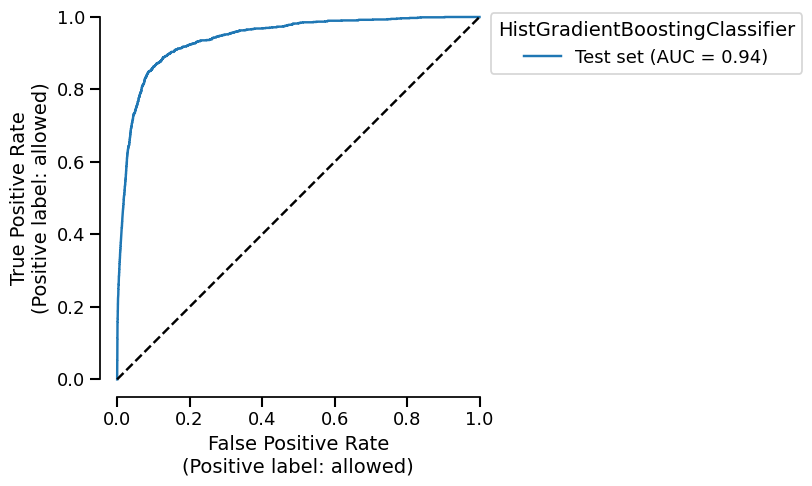
The plot functionality is built upon the scikit-learn display objects. We return
those display (slightly modified to improve the UI) in case we want to tweak some
of the plot properties. We can have quick look at the available attributes and
methods by calling the help method or simply by printing the display.
skore.RocCurveDisplay(...)
╭────────────────────────── RocCurveDisplay ───────────────────────────╮
│ display │
│ ├── Attributes │
│ │ ├── .ax_ │
│ │ ├── .chance_level_ │
│ │ ├── .figure_ │
│ │ └── .lines_ │
│ └── Methods │
│ ├── .frame(...) - Get the data used to create the ROC curve plot. │
│ ├── .plot(...) - Plot visualization. │
│ └── .set_style(...) - Set the style parameters for the display. │
╰───────────────────────────────────────────────────────────────────────╯
display.plot()
_ = display.ax_.set_title("Example of a ROC curve")
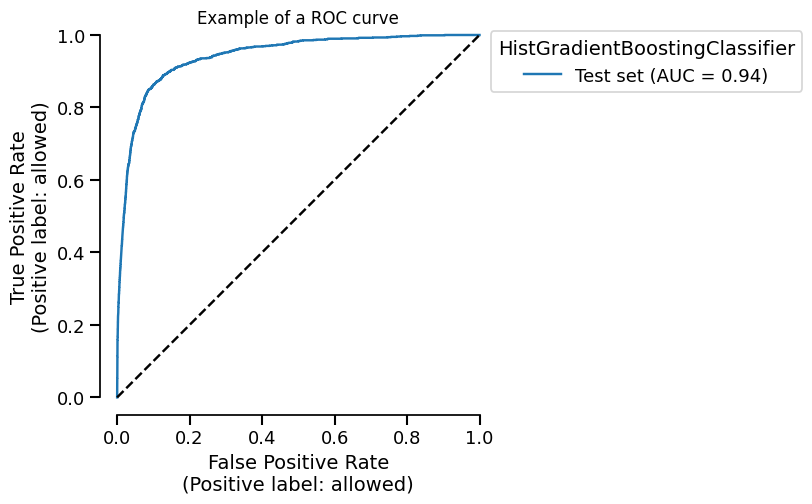
Similarly to the metrics, we aggressively use the caching to avoid recomputing the predictions of the model. We also cache the plot display object by detection if the input parameters are the same as the previous call. Let’s demonstrate the kind of performance gain we can get.

Time taken to compute the ROC curve: 0.05 seconds
Now, let’s clean the cache and check if we get a slowdown.
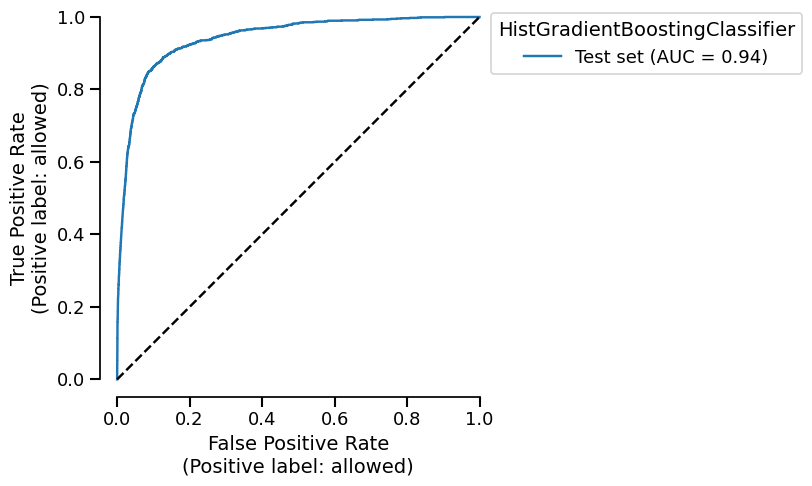
Time taken to compute the ROC curve: 1.62 seconds
As expected, since we need to recompute the predictions, it takes more time.
Visualizing the confusion matrix#
Another useful visualization for classification tasks is the confusion matrix, which shows the counts of correct and incorrect predictions for each class.
Let’s first start with a basic confusion matrix:
cm_display = report.metrics.confusion_matrix()
cm_display.plot()
plt.show()

In binary classification, a confusion matrix depends on the decision threshold used
to convert predicted probabilities into class labels. By default, skore uses a
threshold of 0.5, but confusion matrices are actually computed at every threshold
internally. You can access all available thresholds via the thresholds attribute:
print(f"Number of thresholds: {len(cm_display.thresholds)}")
print(
f"Threshold range: [{cm_display.thresholds.min():.3f}, {cm_display.thresholds.max():.3f}]"
)
Number of thresholds: 18002
Threshold range: [0.000, 0.946]
To visualize the confusion matrix at a different threshold, use the threshold_value
parameter. For example, a threshold of 0.3 will classify more samples as positive:
cm_display.plot(threshold_value=0.3)
plt.show()
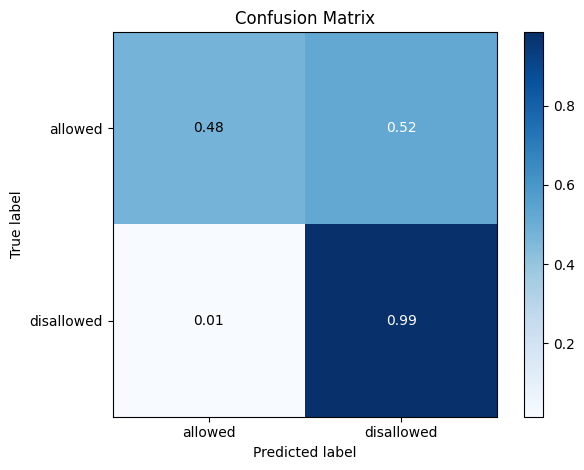
We can normalize the confusion matrix to get percentages instead of raw counts. Here we normalize by true labels (rows):
cm_display.plot(normalize="true")
plt.show()
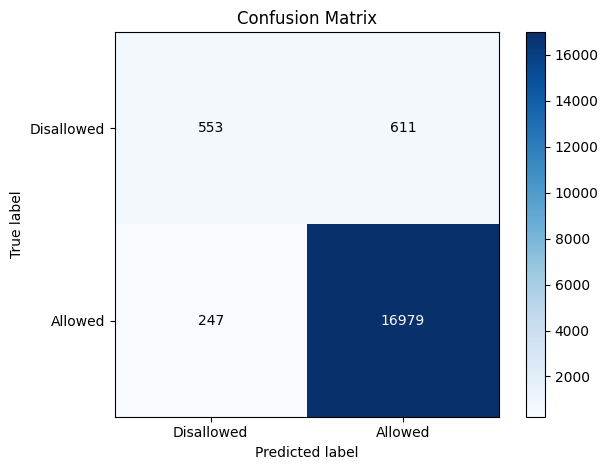
More plotting options are available via heatmap_kwargs, which are passed to
seaborn’s heatmap. For example, we can customize the colormap and number format:
cm_display.plot(heatmap_kwargs={"cmap": "Greens", "fmt": ".2e"})
plt.show()

Finally, the confusion matrix can also be exported as a pandas DataFrame for further analysis:
| true_label | predicted_label | value | threshold | |
|---|---|---|---|---|
| 2844 | disallowed | disallowed | 16976 | 0.500338 |
| 2845 | disallowed | allowed | 250 | 0.500338 |
| 2846 | allowed | disallowed | 634 | 0.500338 |
| 2847 | allowed | allowed | 530 | 0.500338 |
See also
For using the EstimatorReport to inspect your models,
see EstimatorReport: Inspecting your models with the feature importance.
Total running time of the script: (0 minutes 34.649 seconds)